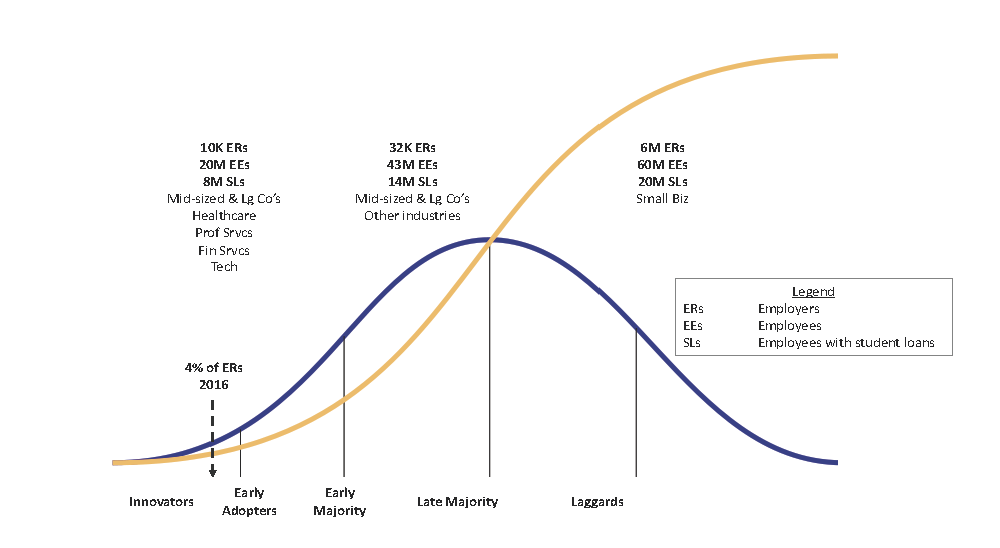After two years of building student loan assistance programs, supporting employers from coast to coast, I want to lay out my observations on where the market is, where it’s going and what’s driving growth.
I believe that student loan assistance will be nearly ubiquitous as an employee benefit among U.S. companies within five years.
In early 2015, the Society for Human Resources Management (SHRM) reported that three percent of its member companies offered student loan aid, and in early 2016, the figure rose to four percent. While an increase of one percent per year may not appear like a lot, it implies a 33 percent market growth rate, which unchanged, would mean that 100 percent of employers will offer student loan aid by 2028.
I believe that 80 percent of employers will offer student loan aid much sooner than 2028. And I’m not alone.
Willis Towers Watson has forecast that 26 percent of U.S. employers will offer student loan repayment by 2018. If we assume that the four percent of SHRM member companies offering student loan aid in 2016 were representative of all U.S. companies, then the Willis report implies that the market for student loan repayment is growing at 155 percent per annum.

Our growth estimate, at 66 percent per year, is about two times the implied SHRM growth rate and about half of the Willis Towers Watson CAGR.
We believe that the addressable market for student loan assistance programs encompasses large, mid-sized and small companies that have an interest in employing the 44 million Americans who are college-educated, driven and hold student debt.
The early adopters of student loan assistance are employers in industries where nearly all jobs require a college degree: professional services firms, technology companies, healthcare organizations and financial institutions.
Top firms in these industries are competing harder than ever with their peers, and across industries, to attract college-educated talent. Their recruiters and hiring managers are operating in a market where more than 95 percent of the workforce is already employed and job opportunities for newly degreed workers are expected to grow 23 percent year over year.
For the early adopters, student loan assistance is a differentiator that is helping employers sign new recruits faster and retain productive team members longer — these advantages can lead to substantial savings on the costs of hiring and employee turnover.
Though the market is growing rapidly, many employers are still able to be among the first in their geography or industry to help employees battle student debt. Check out our client, Medix, a leading staffing firm that was named Best & Brightest Company to Work For in the Nation, citing their student loan assistance program as an important response to challenges presented by employees.
We believe that competition for talent will be the primary driver for adoption of student loan assistance in the near term, as the benefit spreads beyond the first few industries to top firms in industries that employ large numbers of college-educated workers for support and managerial roles such as manufacturing and private education.
Student loan assistance will gain widespread adoption among U.S. employers because it makes financial sense to offer this benefit, even beyond the hiring and turnover savings captured by early adopters:
- Companies are wasting a lot of money on traditional benefits that are not creating engagement. College-educated Millennials prefer student loan repayment two times more than company contributions to retirement plans or supplemental insurances and seven times more than common perks such as free food and gym memberships. Across all generations, student loan assistance is a more strongly considered benefit than tuition reimbursement, gym memberships and free food.
- Recruitment expenses are for naught if candidates decline job offers. Student loan assistance is already a consideration for more than 50 percent of all candidates when choosing between two jobs with differing salaries.
- Companies with diverse workforces are 15-35 percent more likely to outperform. Women hold two-thirds of student debt and African Americans and Hispanics are nearly two times more likely to hold student debt than their white peers. In addition, student loan repayment is more strongly preferred by women and minorities. This is a significant opportunity for companies to engage under-represented groups and achieve the advantages of a diverse workforce.
- Companies with positive work cultures are more productive. Millennials report that paying off their student loans is a more meaningful accomplishment than graduating college, getting their first job or getting a promotion. But today they’re on their own…except for those who work for the companies already offering student loan assistance.

Early adopters and the early majority are most likely to be mid-sized and large employers looking for a programmatic way to engage their teams attract talent, although some small businesses will surely move forward. There are 42,000 large and mid-sized companies in the U.S. that collectively employ ~22 million student loan holders.
Student loan assistance will spread rapidly among the rest of the six million U.S. small businesses that employ another 20 million student debt holders when pending tax changes cause employees to demand this benefit as part of their compensation.
Our country is battling a student loan problem of epic proportions. Today, over 44 million Americans collectively hold more than $1.4 trillion in student loan debt and we’re adding $2,726 per second as north of 70 percent of graduates enter the workforce with college loans — 90 percent + of which is funded by the U.S. federal government.
For the U.S. federal government, it makes sense to provide tax incentives that help citizens reduce their student debt, businesses attract college-educated workers and leverage employer means to reduce the 11.8 percent + default rate on federal student loans.
Over the past year, it has been an honor to work with several members of Congress to investigate and iterate on this solution for America’s student debt crisis. We believe that Congress is likely to pass legislation allowing companies to make pre-tax contributions toward employee student loans. We are encouraged by bicameral momentum that includes bipartisan support for bills such as:
- H.R. 1656 HELP for Students & Parents Act, introduced by a Republican and a Democratic member of Ways & Means
- S. 796 Employer Participation in Student Loan Assistance Act, introduced by a Republican and a Democratic member of the Senate Finance Committee
- H.R. 795 Employer Participation in Student Loan Assistance Act, now counts bi-partisan co-sponsorship from over 100 members of the U.S. House.
In addition to these bills, Peanut Butter and one of the nation’s largest 401(k) record-keepers have recently drafted a deficit-neutral approach to student debt legislation that has been well received by congressional leaders.
Student loan assistance could be the 401(k) of our day. Remember that in 1978, Congress passed the Revenue Act including Internal Revenue Code Sec. 401(k), which helped Americans amass over one trillion dollars in savings in just five years and now helps more than 500,000 employers engage talent by making tax-advantaged retirement savings programs available to 80 percent of full-time American workers, 61 million of whom have now saved over $4.2 trillion for retirement.
Outside the U.S., we believe that student loan assistance may become popular for companies operating in countries where tuition costs and interest rates are high. In Canada, new grads enter the workforce with more than $25,000 in student debt, and we’re already working with one of the country’s top employers to engage their workers with student loan assistance. There may be similar opportunities for employers in Japan and Great Britain. The key for international growth adoption of student loan assistance is local employees’ perceived value of student loan contributions. If local employees have student debt, and have a strong desire to get out from under it, then employers will see a retention advantage of offering student loan repayment, and the ex-U.S. market for student loan repayment will grow.
In summary, there’s still time to be the first employer in your market to offer student loan assistance, but it won’t last long. For employers, the questions are:
- Are we listening?
- Are we leading?
Your employees may not walk up to you and tell you they want help with their student loans, it may be more subtle. Perhaps they are not participating in the company’s 401(k), or perhaps they are speaking with their feet as they choose jobs with other companies.
Depending on whose growth estimate you believe, you may have an opportunity to lead your market by offering student loan assistance this year, or it may be table stakes before you know it.
One thing is for sure — if you wait for legislation to pass, or for everyone else to offer student loan assistance, it will be viewed as an expectation by employees rather than a differentiator for your company.
As a sign of our commitment to the success of our future clients, Peanut Butter can design a free customized student loan assistance plan to efficiently and effectively achieve your talent goals and business objectives.
